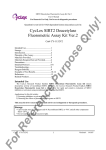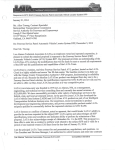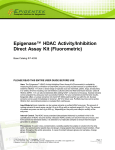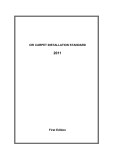Download Data Sheet
Transcript
On ly! SIRT5 Deacetylase Fluorometric Assay Kit User’s Manual For Research Use Only, Not for use in diagnostic procedures Quantitative Assay for NAD-Dependent Deacetylase Activity CycLex SIRT5 Deacetylase Fluorometric Assay Kit 100 Assays Pu rp Intended Use................................................ 1 Storage......................................................... 1 Introduction.................................................. 2 Principle of the Assay.................................. 3 Materials Provided....................................... 4 Materials Required but not Provided........... 4 Precautions................................................... 5 Detailed Protocol.......................................... 6-8 Troubleshooting............................................ 9 Reagent Stability........................................... 9 Example of Test Results............................... 10-11 References.................................................... 12 Related Products........................................... 13 os e Cat# CY-1155 Intended Use ce The CycLex Research Product CycLex SIRT5 Deacetylase Fluorometric Assay Kit detects deacetylase activity of recombinant SIRT5. Primarily, the CycLex Research Product CycLex SIRT5 Deacetylase Fluorometric Assay Kit is designed for the rapid and sensitive evaluation of SIRT5 inhibitors or activators using recombinant SIRT5 or purified SIRT5. en Applications for this kit include: 1) Screening inhibitors or activators of SIRT5. 2) Detecting the effects of pharmacological agents on SIRT5. Storage er This assay kit is for research use only and not for use in diagnostic or therapeutic procedures. rR ef • Upon receipt store #5. Developer and #6. Recombinant SIRT5 at -70°C and all other components below -20°C. • Do not expose reagents to excessive light. Fo Cat#: CY-1155 1 Version#: 150611 On ly! SIRT5 Deacetylase Fluorometric Assay Kit User’s Manual For Research Use Only, Not for use in diagnostic procedures Introduction rR ef er en ce Pu rp os e Sir2 is a conserved protein and was shown to regulate lifespan extension both in budding yeast and nematode. In 2000, it was reported that the yeast Sir2 protein is an NAD(+)-dependent histone deacetylase that plays a critical role in transcriptional silencing, genome stability and longevity. In mammals, the homologs of Sir2 have been identified as Sirtuins (SIRTs), which consist of seven members, termed SIRT1 through SIRT7. They share a conserved central deacetylase domain but have different N- and C-termini and display distinct subcellular localization, suggesting different biological functions (1). The distant mammalian Sir2 homolog SIRT5 localizes in the mitochondrial matrix (2) and interacts with carbamoyl phosphate synthetase 1 (CPS1) which is catalyzing the initial step of the urea cycle for ammonia detoxification and disposal. SIRT5 deacetylates CPS1 and up-regulates its activity (3). Urate oxidase (UOX) were also identified as a target of SIRT5, and its activity was significantly increased by SIRT5-mediated deacetylation in mouse (4). In addition, it was shown that SIRT5 is an efficient protein lysine desuccinylase and demalonylase in vitro. The preference for succinyl and malonyl groups was explained by the presence of an arginine residue (arg105) and tyrosine residue (tyr102) in the acyl pocket of SIRT5 (5). Recently, KO mouse study showed many mammalian proteins have succinyl or malonyl lysine modifications and SIRT5 functions a global regulator of lysine succinylation in mitochondria and present a mechanism for inhibition of ketogenesis (6). Fo Cat#: CY-1155 2 Version#: 150611 On ly! SIRT5 Deacetylase Fluorometric Assay Kit User’s Manual For Research Use Only, Not for use in diagnostic procedures Principle of the Assay os e The CycLex SIRT5 Deacetylase Fluorometric Assay Kit is a simple and homogeneous assay system designed to measure the deacetylase activity of SIRT5. This kit comes with recombinant SIRT5, the acetylated peptide substrate, NAD as a co-substrate and other reagents necessary for the fluorescent deacetylase assay, all of which are ready-to-use. This kit is based on a unique method of CycLex's patents* consisting of the combination of acetylated peptide substrate and peptidase. Fluorophore and quencher are positioned at the amino terminal and the carboxyl terminal of the acetylated peptide which was selected for measurement of the deacetylase activity of SIRT5. Once the substrate is deacetylated by SIRT5, it becomes sensitized to the peptidase. The fluorescence intensity of the fluorophore separated from the quencher by the peptidase treatment is in direct proportion to the deacetylase activity of SIRT5. This unique method is a highly sensitive and convenient alternative to the conventional radioactive acetylated protein methods or HPLC methods for the assay of protein deacetylases. Measuring Principle of The CycLex SIRT5 Deacetylase Fluorometric Assay Kit Pu rp fluorophore - X-X-X-Lys(Ac) -X-X- quencher Deacetylase fluorophore - X-X-X-Lys -X-X- quencher Peptidase fluorophore - X-X-X-Lys + X-X- quencher ce Measurement of fluorescence intensity rR ef er en *Note: This measuring principle and kit are covered under CycLex’s patents. U.S. Patent No. 7,033,778 and No. 7256013 European Patent No. 1243658 Japanese Patent No. 4267043 Canadian Patent No. 2392711 Fo Cat#: CY-1155 3 Version#: 150611 Materials Provided Components of Kit Quantity 1 mL x 2 500 µL x 1 100 µL x 1 500 µL x 1 500 µL x 1 500 µL x 1 1 mL x 2 1 Pu rp Materials Required but not Provided Storage Below -20°C Below -20°C Below -20°C Below -20°C -70°C -70°C Below -20°C Room temp. os e Components #1. SIRT5 Assay Buffer #2. Fluoro-Substrate Peptide (0.1 mM) #3. Fluoro-Deacetylated Peptide (0.1 mM) #4. NAD (8 mM) #5. Developer #6. Recombinant SIRT5 #7. Stop Solution Instruction manual On ly! SIRT5 Deacetylase Fluorometric Assay Kit User’s Manual For Research Use Only, Not for use in diagnostic procedures rR ef er en ce • Microplate for fluorometer • Microplate reading fluorometer capable of excitation at a wavelength in the range 480-500 nm and detection of emitted light in the range 520-540 nm. • Pipettors: 2-20 µL, 20-200 µL and 200-1000 µL precision pipettors with disposable tips. • Multi-channel pipette • Microplate shaker • Deionized water of the highest quality • 500 or 1000 mL graduated cylinder • Reagent reservoirs • Control compound(s) Fo Cat#: CY-1155 4 Version#: 150611 On ly! SIRT5 Deacetylase Fluorometric Assay Kit User’s Manual For Research Use Only, Not for use in diagnostic procedures Precautions • Please thaw “#2. Fluoro-Substrate Peptide” and “#3. Fluoro-Deacetylated Peptide” at room temperature before use. Then, thaw the other reagents in ice and use after they are completely thawed. • Please avoid repeated freezing and thawing of “#5. Developer” and “#6. Recombinant SIRT5”. There is a possibility that the enzyme activity may be inactivated. Aliquot to 10-20 µL and store at -70°C. os e • Please avoid mixing of protease/peptidase inhibitors such as PMSF, or alkyl amine in samples that will be measured SIRT5 activity. • Do not use kit components beyond the indicated kit expiration date. • Rinse all detergent residue from glassware. • Do not mix reagents from different kits. Pu rp • Use deionized water of the highest quality. • Do not mouth pipet or ingest any of the reagents. • Do not smoke, eat, or drink when performing the assay or in areas where samples or reagents are handled. • Biological samples may be contaminated with infectious agents. Do not ingest, expose to open wounds or breathe aerosols. Wear protective gloves and dispose of biological samples properly. ce NOTE: THE FOLLOWING PROCEDURES ARE INTENDED ONLY AS A GUIDELINE. THE OPTIMAL EXPERIMENTAL CONDITIONS WILL VARY DEPENDING ON THE PARAMETERS BEING INVESTIGATED, AND MUST BE DETERMINED BY THE INDIVIDUAL USER. rR ef er en For research use only, not for use in diagnostic or therapeutic procedures Fo Cat#: CY-1155 5 Version#: 150611 On ly! SIRT5 Deacetylase Fluorometric Assay Kit User’s Manual For Research Use Only, Not for use in diagnostic procedures Detailed Protocol 1. Assay Method for Measurement of SIRT5 Activity os e The CycLex SIRT5 Deacetylase Fluorometric Assay Kit can measure the deacetylase activity of SIRT5 with a homogeneous method. In this method, the reaction is initiated and the fluorescence intensity is measured by mixing simultaneously fluorescence-labeled acetylated peptide, which is a substrate, SIRT5, NAD and the developer. Since the reaction is not stopped, it is necessary to measure fluorescence intensity at regular intervals after the reaction is initiated, and to determine reaction velocity. Alternatively, within a time in which the reaction velocity is kept constant, it is also possible to stop the reaction by adding stop solution and to measure fluorescence intensity. 1) Following Table.1 below, first, add “Distilled water”, “#1. SIRT5 Assay Buffer”, “#2. Fluoro-Substrate Peptide” and “#4. NAD” to microtiter plate wells. Second “#5. Developer” to each well of the microtiter plate and mix well. Table.1: Reaction mixture for measurement of SIRT5 activity No Enzyme Control Assay 25 µL 5 µL 5 µL 5 µL Positive Control Assay 25 µL 5 µL 5 µL 5 µL No NAD Control Assay 30 µL 5 µL 5 µL - #5. Developer 5 µL 5 µL 5 µL 5 µL Enzyme Sample Buffer of Enzyme Sample #6. Recombinant SIRT5 5 µL - 5 µL - 5 µL 5 µL - 50 µL 50 µL 50 µL Total Volume of the mixture ce Distilled water #1. SIRT5 Assay Buffer #2. Fluoro-Substrate Peptide #4. NAD Pu rp Enzyme Sample Assay 25 µL 5 µL 5 µL 5 µL Assay reagents 50 µL en 2) Initiate reactions by adding 5 µL of your “Enzyme Sample” or “Buffer of Enzyme Sample” or “#6. Recombinant SIRT5” to each well and mixing thoroughly at room temperature. 3) Read fluorescence intensity for 30 to 60 minutes at 1 to 2 minutes intervals using microtiter plate fluorometer with excitation at 480-500 nm and emission at 520-540 nm. Measure and calculate the rate of reaction while the reaction velocity remains constant. er Alternate procedure ef 3’) While the reaction rate is kept constant, add 20 µL of “#7. Stop Solution” to each well at appropriate time to stop the reaction, and measure fluorescence intensity in a microplate fluorescence reader capable of excitation at a wavelength in the range 480-500 nm and detection of emitted light in the range 520-540 nm. rR Note-1: During the time in which SIRT5 reaction rate is maintained, the difference in fluorescence intensity between “Enzyme Sample Assay” and “No Enzyme Control Assay” indicates the SIRT5 activity of your “Enzyme Sample”. Fo Cat#: CY-1155 6 Version#: 150611 On ly! SIRT5 Deacetylase Fluorometric Assay Kit User’s Manual For Research Use Only, Not for use in diagnostic procedures Note-2: Although the volume of addition of “Enzyme Sample” or “Buffer of Enzyme Sample” or “#6. Recombinant SIRT5” is set to 5 µL in Table.1, it may be changed to a volume up to 20 µL at your discretion. In that case, please reduce the volume of “Distilled water” to set the final reaction volume of 50 µL. Note-3: If enzyme samples contain some protease/peptidase able to break down “#2. Fluoro-Substrate Peptide”, resulting in an increase of fluorescence intensity in “No NAD Control Assay”, the SIRT5 activity in the samples cannot be evaluated correctly. os e Note-4: If enzyme samples contain inhibitors for protease/peptidase, precise SIRT5 enzyme activity cannot be measured. Since protease/peptidase inhibitors used in the usual protein purification process strongly inhibit the peptidase activity in the development reaction, please avoid using any protease/peptidase inhibitors during the process of protein purification. Note-5: If enzyme samples have an inhibitory effect on the peptidase in the development reaction, the final fluorescence intensity will not increase. Please use “#3. Fluoro-Deacetylated Peptide” instead of “#2. Fluoro-Substrate Peptide”, and conduct a control experiment. Pu rp 2. Assay Procedures for Inhibitor/Activator Screening 1) Following Table.2 below, first, add “Distilled water”, “#1. SIRT5 Assay Buffer”, “#2. Fluoro-Substrate Peptide” or “#3. Fluoro-Deacetylated Peptide” and “#4. NAD” to microtiter plate wells. Second, add “Test Compound” or “Solvent of Test Compound” or “Control Compound (not provided)”, and “#5. Developer” to each well of the microtiter plate and mix well. Table.2: Reaction mixture for inhibitor/activator screening #5. Developer er #6. Recombinant SIRT5 (or Enzyme Sample) Solvent Control Assay 20 µL 5 µL 5 µL 5 µL 5 µL - Control Compound Assay 20 µL 5 µL 5 µL 5 µL 5 µL No Enzyme Control Assay 25 µL 5 µL 5 µL 5 µL 5 µL - Development Control Assay 30 µL 5 µL 5 µL 5 µL - 5 µL 5 µL 5 µL 5 µL 5 µL 5 µL 5 µL 5 µL - - 50 µL 50 µL 50 µL 50 µL 50 µL en Distilled water #1. SIRT5 Assay Buffer #2. Fluoro-Substrate Peptide #3. Fluoro-Deacetylated Peptide #4. NAD Test Compound Solvent of Test Compound Control Compound (not provided) Test Compound Assay 20 µL 5 µL 5 µL 5 µL 5 µL - ce Assay reagents ef Total Volume of the mixture 2) Initiate reactions by adding 5 µL of “#6. Recombinant SIRT5” (or your “Enzyme Sample”) to each well and mixing thoroughly at room temperature. rR 3) Read fluorescence intensity for 30 to 60 minutes at 1 to 2 minute intervals using microtiter plate fluorometer with excitation at 480-500 nm and emission at 520-540 nm. Measure and calculate the rate of reaction while the reaction velocity remains constant. Fo Cat#: CY-1155 7 Version#: 150611 On ly! SIRT5 Deacetylase Fluorometric Assay Kit User’s Manual For Research Use Only, Not for use in diagnostic procedures Alternate procedure 3’) While the reaction rate is kept constant, add 20 µL of “#7. Stop Solution” to each well at appropriate time to stop the reaction, and measure fluorescence intensity in a microplate fluorescence reader capable of excitation at a wavelength in the range 480-500 nm and detection of emitted light in the range 520-540 nm. os e Note-1: During the time in which SIRT5 reaction rate is maintained, the difference in fluorescence intensity between “Solvent Control Assay” and “No Enzyme Control Assay” indicates the SIRT5 activity. Pu rp Note-2: In order to estimate the active or inhibitory effect on SIRT5 activity by the test compounds correctly, it is necessary to conduct the control experiment of “Solvent Control Assay” at least once for every experiment and “Control Compound Assay” at least once for the first experiment, in addition to “Test Compound Assay” as indicated in the Table.2. When test compounds cause an active or inhibitory effect on SIRT5 activity, the level of increase of fluorescence intensity is strengthened or weakened as compared with “Solvent Control Assay”. Note-3: The efficacy of the test compounds on the SIRT5 activity is the difference in fluorescence intensity between [“Test Compound Assay” minus “No Enzyme Control Assay”] and [“Solvent Control Assay” minus “No Enzyme Control Assay”]. Note-4: If test compounds have an inhibitory effect on protease/peptidase, resulting that the increase in fluorescence intensity is not or a little observed in “Development Control Assay”, the effect on SIRT5 activity cannot be evaluated correctly. ce Note-5: Although the above tables indicate the volume of addition of “Test Compound” or “Solvent of Test Compound” or “Control Compound (not provided)” as 5 µL, the concentration and the volume of the reagents to add can be changed so that the concentration of test compounds becomes the setting concentration. For example, since the final volume of reaction is 50 µL here, it is also possible to add 10 µL of “Test Compound” or “Solvent of Test Compound” or “Control Compound (not provided)”. In this case, please reduce the volume of “Distilled water” to set the final reaction volume of 50 µL. rR ef er en Note-6: Although the volume of addition of “Recombinant SIRT5” or your “Enzyme Sample” is set to 5 µL in above tables, it may be changed to a volume up to 20 µL at your discretion. In that case, please reduce the volume of “Distilled water” to set the final reaction volume of 50 µL. Fo Cat#: CY-1155 8 Version#: 150611 On ly! SIRT5 Deacetylase Fluorometric Assay Kit User’s Manual For Research Use Only, Not for use in diagnostic procedures Troubleshooting 1. Final fluorescence intensity will not increase, both when test chemicals have an inhibitory effect on SIRT5, and also when there is an inhibitory effect on the peptidase. 2. If the test reagents themselves emit fluorescence at excitation wavelength: 480-500 nm and fluorescence wavelength: 520-540 nm, the inhibitory effect of the test assay cannot be evaluated correctly. os e 3. The recombinant SIRT5 should be run in duplicate, using the protocol described in the Detailed Protocol. Incubation times or temperatures significantly different from those specified may give erroneous results. 4. The reaction curve is nearly a straight line if the kinetics of the assay is of the first order. Variations in the protocol can lead to non-linearity of the curve, as can assay kinetics that are other than first order. For a non-linear curve, point to point or quadratic curve fit methods should be used. Pu rp 5. Poor duplicates indicate inaccurate dispensing. If all instructions in the Detailed Protocol were followed accurately, such results indicate a need for multi-channel pipettor maintenance. Reagent Stability rR ef er en ce All of the reagents included in the CycLex Research Product CycLex SIRT5 Deacetylase Fluorometric Assay Kit have been tested for stability. Reagents should not be used beyond the stated expiration date. Upon receipt, store the “#5. Developer” and “#6. Recombinant SIRT5” at -70°C, all other kit reagents should be stored below -20°C. Fo Cat#: CY-1155 9 Version#: 150611 Example of Test Results Pu rp os e Fig.1 Time course of substrate deacetylation by recombinant SIRT5 On ly! SIRT5 Deacetylase Fluorometric Assay Kit User’s Manual For Research Use Only, Not for use in diagnostic procedures (NAD Conc.: 800 µM) rR ef er en ce Fig.2 NAD dependency of recombinant SIRT5 activity Fo Cat#: CY-1155 (Recombinant SIRT5: 2.0 µg in 50uL assay) 10 Version#: 150611 On ly! SIRT5 Deacetylase Fluorometric Assay Kit User’s Manual For Research Use Only, Not for use in diagnostic procedures rR ef er en ce Pu rp os e Fig.3 Effect of compounds on recombinant SIRT5 activity Fo Cat#: CY-1155 11 Version#: 150611 On ly! SIRT5 Deacetylase Fluorometric Assay Kit User’s Manual For Research Use Only, Not for use in diagnostic procedures References 1. North BJ et al.: Sirtuins: Sir2-related NAD-dependent protein deacetylases. Genome Biol. 5: 224, 2004 2. Michishita E et al.: Evolutionarily conserved and nonconserved cellular localizations and functions of human SIRT proteins. Mol Biol Cell. 16:4623, 2005 os e 3. Nakagawa T et al.; SIRT5 Deacetylates carbamoyl phosphate synthetase 1 and regulates the urea cycle. Cell. 137: 560, 2009 4. Nakagawa T et al.; SIRT5 deacetylates and activates urate oxidase in liver mitochondria of mice. FEBS Lett. 586:4076, 2012 5. Du J et al.; Sirt5 is a NAD-dependent protein lysine demalonylase and desuccinylase. Science 334: 806, 2011. rR ef er en ce Pu rp 6. Rardin MJ et al.; SIRT5 regulates the mitochondrial lysine succinylome and metabolic networks. Cell Metab. 18:920, 2013 Fo Cat#: CY-1155 12 Version#: 150611 On ly! SIRT5 Deacetylase Fluorometric Assay Kit User’s Manual For Research Use Only, Not for use in diagnostic procedures Related Products os e Kit * CycLex Cellular Histone Acetylation Assay Kit: Cat# CY-1140 * CycLex HDACs Deacetylase Fluorometric Assay Kit Ver.2: Cat# CY-1150V2 * CycLex SIRT1/Sir2 Deacetylase Fluorometric Assay Kit Ver.2: Cat# CY-1151V2 * CycLex SIRT2 Deacetylase Fluorometric Assay Kit Ver.2: Cat# CY-1152V2 * CycLex SIRT3 Deacetylase Fluorometric Assay Kit Ver.2: Cat# CY-1153V2 * CycLex SIRT5 Deacetylase Fluorometric Assay Kit: Cat# CY-1155 * CycLex SIRT6 Deacetylase Fluorometric Assay Kit Ver.2: Cat# CY-1156V2 * CycLex HDAC8 Deacetylase Fluorometric Assay Kit Ver.2: Cat# CY-1158V2 * CycLex NAMPT Colorimetric Assay Kit: CY-1251 * CycLex NMNAT Colorimetric Assay Kit: CY-1252 * CycLex NAD+/NADH Colorimetric Assay Kit: CY-1253 Pu rp Enzyme * CycLex NAD(+)-Dependent Deacetylase SIRT1: Cat# CY-E1151 * CycLex NAD(+)-Dependent Deacetylase SIRT2: Cat# CY-E1152 * CycLex NAD(+)-Dependent Deacetylase SIRT3: Cat# CY-E1153 * CycLex NAD(+)-Dependent Deacetylase SIRT5: Cat# CY-E1155 * CycLex NAD(+)-Dependent Deacetylase SIRT6: Cat# CY-E1156 * CycLex NAMPT (Nicotinamide Phosphoribosyltransferase): Cat# CY-E1251 * CycLex NMNAT1 (Nicotinamide Mononucleotide Adenylyltransferase 1): Cat# CY-E1252 ce Antibody * Anti-Acetylated Histone/p53-K382 Mouse Monoclonal Antibody: Cat# CY-M1029 * Anti-Histone Deacetylase 1 (HDAC1) Rabbit Polyclonal Antibody: Cat# CY-P1011 * Anti-Histone Deacetylase 2 (HDAC2) Rabbit Polyclonal Antibody: Cat# CY-P1012 * Anti-Human SIRT1 Rabbit Polyclonal Antibody: Cat# CY-P1016 PRODUCED BY en This product is covered under CycLex’s patents. U.S. Patent No. 7,033,778 and No. 7256013 European Patent No. 1243658 Japanese Patent No. 4267043 Canadian Patent No. 2392711 ef er CycLex Co., Ltd. 1063-103 Terasawaoka Ina, Nagano 396-0002 Japan Fax: +81-265-76-7618 e-mail: [email protected] URL: http://www.cyclex.co.jp rR CycLex/CircuLex products are supplied for research use only. CycLex/CircuLex products and components thereof may not be resold, modified for resale, or used to manufacture commercial products without prior written approval from CycLex Co., Ltd.. To inquire about licensing for such commercial use, please contact us via email. Fo Cat#: CY-1155 13 Version#: 150611

























